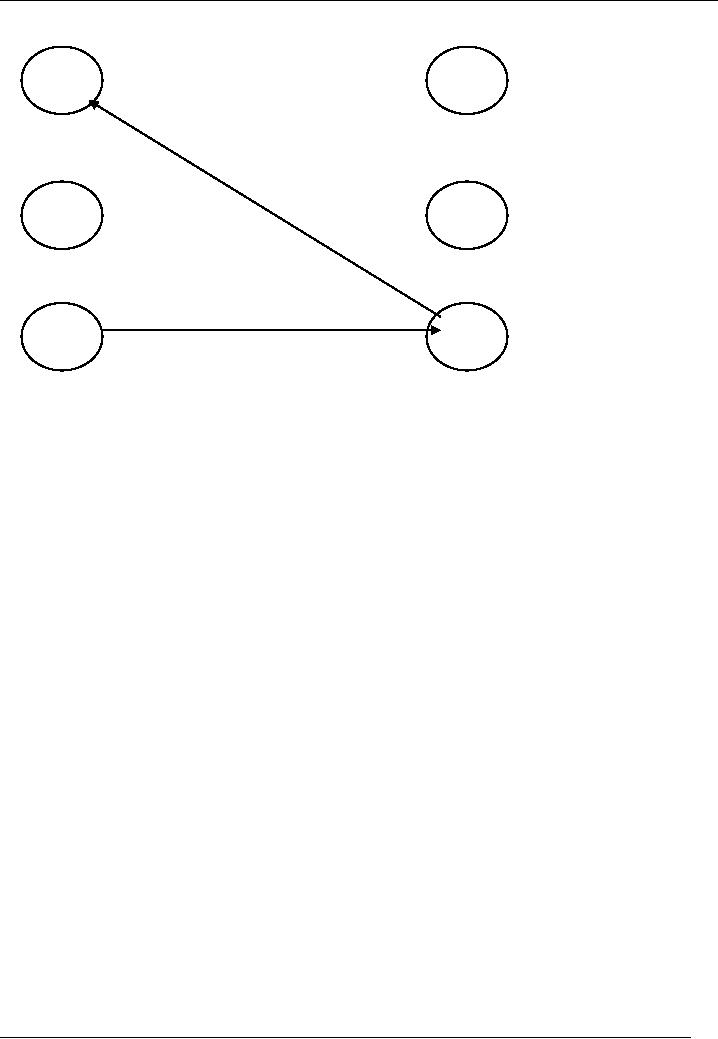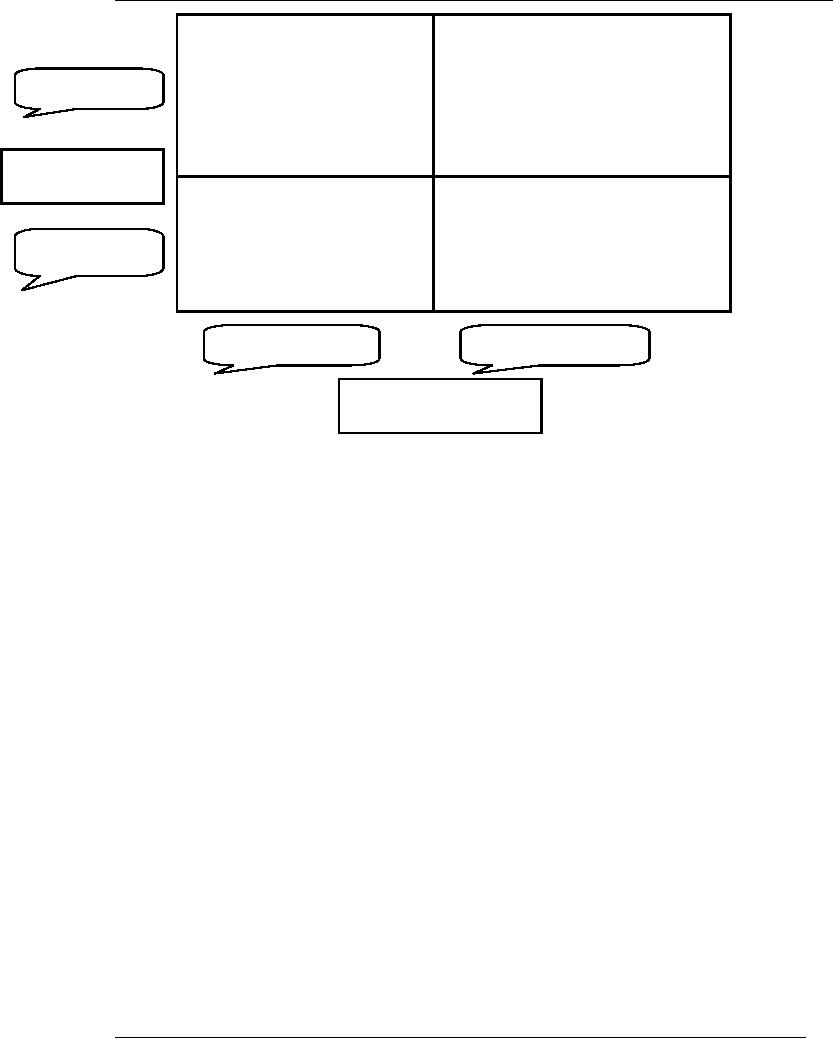 |
TYPES OF TRANSACTIONS:Complementary Transactions, Crossed Transactions, Ulterior Transactions |
| << TRANSACTIONAL ANALYSIS:EGO STATES, Parent Ego State, Child Ego State |
| NEURO-LINGUISTIC-PROGRAMMING >> |

Human
Resource Development (HRM-627)
VU
Lesson
11
TYPES
OF TRANSACTIONS
Within
ego states there are
three different types of
transaction: complementary,
crossed, and ulterior
Complementary
Transactions
A
complementary transaction occurs when the
sender of the message gets the intended
response from the
receiver.
For example, an employee
makes a mistake and, wanting
some sympathy, apologizes to the
boss.
Employee
`I just dropped the thing when I
was almost done. Now I
have to do it all over
again.'
Supervisor
`It happens to all of
us; don't worry about it.'
This complementary transaction is illustrated
below.
SUPERVISOR
EMPLOYEE
P
P
A
A
C
C
Another
example of a complementary transaction is
a supervisor who wants a job
done and delegates
it,
expecting
the employee to do it. The
supervisor behaves on an adult-to-adult
level. Supervisor `please get
this
order
ready for me by two
o'clock.' Employee `I'll have it
done before two o' clock, no
problem.'
Generally,
complementary transactions result in
more effective communication with fewer
hurt feelings and
arguments.
In other words, they help
human relations and performance.
Exceptions are if an employee uses
an
adapted
child or critical parent ego state
and the supervisor does,
too. These complementary
transactions can
lead
to problems.
Crossed
Transactions
Crossed
transactions occur when the
sender of the message does
not get the expected
response from the
receiver.
Returning to our first example: Employee
`I just dropped the thing when I
was almost done. Now
I
have
to do it all over again.'
Supervisor `you are so
clumsy.' This transaction is illustrated
below.
33

Human
Resource Development (HRM-627)
VU
SUPERVISOR
EMPLOYEE
P
P
A
A
C
C
From
our second example:
Supervisor `please get this
order ready for me by two o'
clock.' Employee `why
do
I have to do it? Why don't
you do it yourself? I am busy.' This
cross transaction is an adult
adapted to
child
response.
Generally,
cross transactions result in
surprise, disappointment, and hurt
feelings for the sender of the
message.
The
unexpected response often
gets the person emotional, which
often results in his or her
changing to the
adapted
child ego sate, which
causes the communication to deteriorate further.
Cross transactions often end
in
arguments
and hurt human
relations.
Cross
transactions can be helpful when the
negative parent or child ego
response is crossed with an
adult
response.
This cross over may
result in the preferred adult to
adult conversation.
Ulterior
Transactions
Ulterior,
or hidden, transactions occur when the
words seem to be coming from
one ago state, but in
reality the
words
or behaviors are coming from
another. For example, after a
training program, one of the
participants
came
up to a consultant asking advice on an
adult ego sate. When the
consultant gave advice, the
participant
twice
had quick responses as to
why the advice would not
work (child rather than
adult behavior). The
consultant
realized that what the participant
actually wanted was
sympathetic understanding for his
situation,
not
advice. The consultant stopped making
suggestions and listened actively,
using reflective responses.
The
consultant
changed from the adult to the
sympathetic parent ego state in
order to have a complimentary
transaction.
Sometimes
people don't know what they want or how
to ask for it in a direct way, so they
use ulterior
transactions.
When possible, it is best to
avoid ulterior transactions
because they tend to waste time.
Avoid
making
people search for your
hidden meanings. Plan your
message before you send it.
When receiving
messages
look for ulterior
transactions and turn them
into complimentary transactions, as
stated above.
Life
Positions
Attitudes
affect your behavior and
human relations. Within the TA framework,
you have attitudes
toward
yourself
and toward others. Positive attitudes
are described as OK, and
negative attitudes are
described as
NOT
OK. The four life positions
are illustrated below.
34

Human
Resource Development (HRM-627)
VU
I'm
OK You're not OK
I'm
OK You're OK
POSITIVE
Attitude
towards
oneself
I'm
not OK You're not
OK
I'm
not OK You're OK
NEGATIVE
NEGATIVE
POSITVE
Attitudes
toward others
The
most desirable life position
is shown in the upper right hand
box: "I am OK You are
OK". With a
positive
attitude towards yourself and
others, you have a greater
chance for having adult to
adult ego state
communication.
You can change your
attitude, and you should, if they are
not positive, to create win
win
situations.
People with a positive
self-concept tend to have
positive attitudes.
35
Table of Contents:
- INTRODUCTION TO HUMAN RESOURCE DEVELOPMENT:The Concept and its Dimensions, Targets of Development
- FOUNDATIONS OF HUMAN BEHAVIOR:Attitudes, Personality, Emotional Intelligence
- PERCEPTION:Attribution Theory, Shortcuts Frequently Used in Judging Others
- INTRINSIC MOTIVATION:Why Choose Big Five Framework?, THE OUTCOME OF FIVE FACTOR MODEL
- FIVE FACTOR MODEL:The Basis of Intrinsically Motivated Behavior, Intrinsic Motivation and Values
- MOTIVATION:EARLY THEORIES OF MOTIVATION, Designing Motivating Jobs
- The Motivation Process:HOW TO MOTIVATE A DIVERSE WORKFORCE?,
- INTERPERSONAL COMMUNICATION:PRINCIPLES OF INTERPERSONAL COMMUNICATION
- THE WORLD BEYOND WORDS:DIFFERENCES BETWEEN VERBAL AND NONVERBAL COMMUNICATION, MINDFUL LISTENING
- TRANSACTIONAL ANALYSIS:EGO STATES, Parent Ego State, Child Ego State
- TYPES OF TRANSACTIONS:Complementary Transactions, Crossed Transactions, Ulterior Transactions
- NEURO-LINGUISTIC-PROGRAMMING
- CREATE YOUR OWN BLUEPRINT
- LEADERSHIP:ORGANIZATIONAL DEMOCRACY
- LEADERSHIP:Environment and Strategic Leadership Link, Concluding Remarks
- UNDERSTANDING GROUP BEHAVIOR:Stages of Group Development, Advantages of Group Decision Making
- UNDERSTANDING TEAM BEHAVIOR:TYPES OF TEAMS, Characteristics of Effective Teams,
- EMOTIONAL FACET:PHYSICAL FACET
- HUMAN RESOURCE DEVELOPMENT & THE ROLE OF GOVERNACE:Rule of Law, Transparency,
- HUMAN RESOURCE DEVELOPMENT:The Concept and Its Dimensions, Targets of Development
- HUMAN DEVELOPMENT INDEX (HDI):Methodology,
- REPORTS:Criticisms of Freedom House Methodology, GROSS NATIONAL HAPPINESS
- SECTORS OF A SOCIETY: SOME BASIC CONCEPTS:PUBLIC SECTOR, PRIVATE SECTOR
- NON GOVERNMENTAL ORGANIZATIONS (NGOS):Types, Methods, Management, Citizen organization
- HEALTH SECTOR:Health Impact of the Lebanon Crisis, Main Challenges,
- A STUDY ON QUALITY OF PRIMARY EDUCATION BACKGROUND AND RATIONALE
- ADULT EDUCATION:Lifelong learning
- THE PRACTICAL PERSPECTIVE OF ADULT EDUCATION:Problems of Adult Literacy, Strategies for Educating Adults for the Future
- TECHNICAL & VOCATIONAL EDUCATION:VET Internationally, Technical Schools
- ASSESSING THE LINK BETWEEN INTELLECTUAL CAPITAL FORMATION AND PERFORMANCE OF A UNIVERSITY
- SCIENCE & TECHNOLOGY EDUCATION:Social responsibility, Curriculum content
- ENVIRONMENT:Dark Greens and Light Greens, Environmental policy instruments
- HDI AND GENDER SENSITIVITY:Gender Empowerment Measure
- THE PLIGHT OF INDIAN WOMEN:
- ENTREPRENEURSHIP:Characteristics of entrepreneurship, Advantages of Entrepreneurship
- A REVISIT OF MODULE I & II
- HUMAN DEVELOPMENT & ECONOMIC GROWTH (1975 TO 2003):
- PUBLIC PRIVATE PARTNERSHIP:Origins, The Desired Outcomes of PPPs
- PRINCIPLES OF PUBLIC PRIVATE PARTNERSHIP (PPP):Situation in Pakistan,
- DEVOLUTION REFORMS – A NEW SYSTEM OF GOVERNMENT:
- GOOD GOVERNANCE:Participation, Rule of law, Accountability
- MACROECONOMIC PROFILE OF A COUNTRY: EXAMPLE ECONOMY OF PAKISTAN
- COORDINATION IN GOVERNANCE: AN EXAMPLE OF EU, The OMC in Social Inclusion
- MOBILIZING REGIONAL EDUCATIONAL RESOURCES: THE ASEAN UNIVERSITY NETWORK, A CASE STUDY
- GOVERNMENT PRIORITIES AND POLICIES:Role of Government, Socio Cultural Factors in Implementing HRD Programs